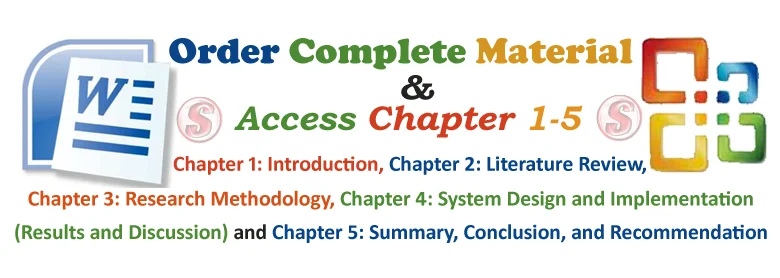1.0 Introduction
1.1 Background of Study
Birth preparedness and complication readiness (BP/CR) is a comprehensive package aimed at promoting timely access to skilled maternal and neonatal services (Markos and Bogale, 2014; Kaso and Addisse, 2014). It includes knowledge of danger signs, planning for a birth attendant and birth location, arranging transportation, identifying a blood donor, and saving money in the case of an obstetric complication (Mbalinda et al., 2014; Urassa and Pembe, 2012).
Birth preparedness has been globally endorsed as an essential component of safe motherhood programs to reduce delays to care-seeking for obstetric emergencies - delay in recognition of problem, delay in seeking care, and delay in receiving care at facility. These delays represent barriers that often result in preventable maternal deaths. The presence of a skilled birth attendant (SBA) at delivery is recognized as essential to preventing maternal mortality (JHPIEGO, 2004b; McPherson et al., 2006).
The principle and practice of Birth Preparedness and Complication readiness (BP/CR) in a third world setting where there is prevailing illiteracy, inefficient infrastructure, poor transport system, and unpredictable access to skilled care provider have the potential of reducing the existing high maternal and neonatal morbidity and mortality rates. BP/CR promotes skilled care for all births and encourages decision making before the onset of labor (Ekabua et al., 2011).
The safe motherhood plan of the Ministry of Health and Population defines a range of complementary interventions to improve maternal and newborn health, one of which is the birth-preparedness package (BPP). The purpose of the package is to encourage pregnant women, their families, and communities to plan for normal pregnancies, deliveries, and postnatal periods and to prepare to deal effectively with emergencies if they occur. The BPP is a demand-creation intervention that promotes key messages and behaviour change via inter-personal communication through community health volunteers (McPherson et al., 2006; DOHS, 2014)
The majority of pregnant women and their families do not know how to recognize the danger signs of complications and when complications occur they will waste a great deal of time in recognizing the problem, getting organized, getting money, finding transport and reaching the appropriate referral facility (Moore et al., 2002). With the assumption that “every pregnancy faces risks”, women should be made aware of danger signs of obstetric complications during pregnancy, delivery and the postpartum, the knowledge will ultimately empower them and their families to make prompt decisions to seek care from skilled birth attendants (Kabakyenga et al., 2011).
Therefore, in Ado-Ekiti where the research was carried out, the activities that was conducted is to know the Knowledge and Practices of Birth Preparedness and Complication readiness among Pregnant Women in the Primary Health Care Facilities.
1.2 Statement of Problems
Investigation revealed that despite various health interventions and educational programs aimed at improving maternal and newborn health, many pregnant women still lack adequate knowledge and practice of birth preparedness and complication readiness. This gap is concerning, given the high rates of maternal and neonatal complications and mortality in many regions. Pregnant women often do not have comprehensive information about recognizing danger signs during pregnancy, preparing for birth, and arranging for emergency care, which leads to delayed responses in critical situations (Mbalinda et al., 2014).
The existing programs may not be sufficiently reaching the target populations or may not be effectively tailored to address local challenges and cultural beliefs (Urassa et al., 2012). Moreover, there is a lack of robust data on the effectiveness of current strategies in improving birth preparedness and complication readiness (Pembe et al., 2010). It is against the backdrop that this study seeks to address these problems by evaluating the knowledge and practices of birth preparedness and complication readiness among pregnant women in the Primary Health Care Facilities
1.3 Aim and Objectives of Study
This aim of the study is to determine the Knowledge and Practices of Birth Preparedness and Complication readiness among Pregnant Women in the Primary Health Care Facilities in Ado-Ekiti. In achieving this aim, the following objectives were laid out as follows:
- To determine knowledge regarding birth preparedness and complication readiness of mothers in Ado-Ekiti
- To find out the association between knowledge regarding birth preparedness and complication readiness and place of delivery.
- To evaluate the knowledge on Birth Preparedness and Complication readiness and obstetric danger signs.
1.4 Research Questions
The study came up with research questions so as to be able to ascertain the above stated objectives. The specific research questions for the study are stated below as follows:
- Are Pregnant Women in the Primary Health Care Facilities in Ado-Ekiti aware about Knowledge and Practices of Birth Preparedness and Complication readiness?
- Do mothers have knowledge about the danger signs of BP/CR during pregnancy?
- Is there any association between the knowledge regarding BP/CR and socio-demographic characteristics of Pregnant Women in the Primary Health Care Facilities in Ado-Ekiti?
- Is there any association between knowledge and practices of birth preparedness and complication readiness regarding danger signs during pregnancy?
1.5 Research Hypothesis
In order to pursue the objective of this study, the following generalized statements have been designed to guide and aids in obtaining the result for the experiment to be conducted. For this work, the null hypothesis will be represented with H0 while the alternative hypothesis will be represented with hypothesis H1.
Hypothesis One
- H0: There is no significant relationship between the knowledge regarding BP/CR and socio-demographic characteristics of Pregnant Women in the Primary Health Care Facilities in Ado-Ekiti
- H1: There is significant relationship between the knowledge regarding BP/CR and socio-demographic characteristics of Pregnant Women in the Primary Health Care Facilities in Ado-Ekiti
Hypothesis Two
- H0: There is no significant relationship between knowledge and practices of birth preparedness and complication readiness regarding danger signs during pregnancy
- H1: There is significant relationship between knowledge and practices of birth preparedness and complication readiness regarding danger signs during pregnancy
1.6 Significance of Study
The study will provide valuable insights for healthcare providers by highlighting areas where improved education and counseling on birth preparedness and complication readiness are needed. Also, the findings will inform policymakers on the importance of integrating comprehensive birth preparedness and complication readiness programs into maternal health strategies, potentially leading to better health outcomes.
Additionally, community health workers will benefit from understanding the gaps in knowledge and practices, enabling them to design targeted interventions that address the specific needs of pregnant women.
Furthermore, the study will assist pregnant women and their families in recognizing the critical role of birth preparedness in ensuring safe delivery, thereby promoting proactive health-seeking behaviors.
Finally, the research will contribute to academic knowledge by offering evidence that can guide further studies and inform training programs for maternal health professionals.
1.7 Scope of Study
The scope of this research is focused on the determination of the Knowledge and Practices of Birth Preparedness and Complication readiness among Pregnant Women in the Primary Health Care Facilities in Ado-Ekiti, Ekiti State.
1.8 Limitations of the Study
The study was limited by several factors, including insufficient data due to the unavailability of comprehensive records and reluctance of some respondents to fully participate. Frequent power failures during data collection and analysis disrupted the research process and delayed progress. There were also significant delays from respondents in completing questionnaires and interviews, which affected the timeline of the study. Financial constraints limited the scope of the study, restricting the ability to reach a larger sample size or conduct more in-depth follow-up. Time constraints were also a challenge, as the study was conducted within a fixed period, limiting the extent of data gathering and analysis.
1.9 Definition of Terms
Knowledge refers to the awareness and understanding of information related to birth preparedness and complication readiness. According to Ajzen (1991), knowledge encompasses the facts, skills, and experiences individuals acquire through learning, which influences their ability to make informed decisions.
Practices are the actions or behaviors that individuals engage in regarding birth preparedness and complication readiness. As stated by Kothari (2004), practices are repetitive behaviors that result from applying knowledge and skills within specific contexts, often shaped by cultural and social factors.
Birth Preparedness is the process of planning and arranging for a safe delivery. It involves identifying a healthcare facility, arranging transport, saving money for delivery expenses, and identifying a skilled birth attendant. The World Health Organization (WHO, 2015) defines birth preparedness as a strategy designed to encourage pregnant women and their families to make arrangements for timely and appropriate care during pregnancy, childbirth, and the postpartum period.
Complication Readiness involves recognizing danger signs during pregnancy and childbirth, and taking prompt action to access emergency care when needed. According to JHPIEGO (2004), complication readiness entails preparing for potential emergencies by identifying emergency transport, donors for blood transfusions, and appropriate healthcare facilities.
Maternal Health is defined as the health of women during pregnancy, childbirth, and the postpartum period. It involves the prevention and treatment of conditions that could affect women’s well-being during this time (UNICEF, 2017). Effective maternal health practices are closely linked to birth preparedness and complication readiness.




